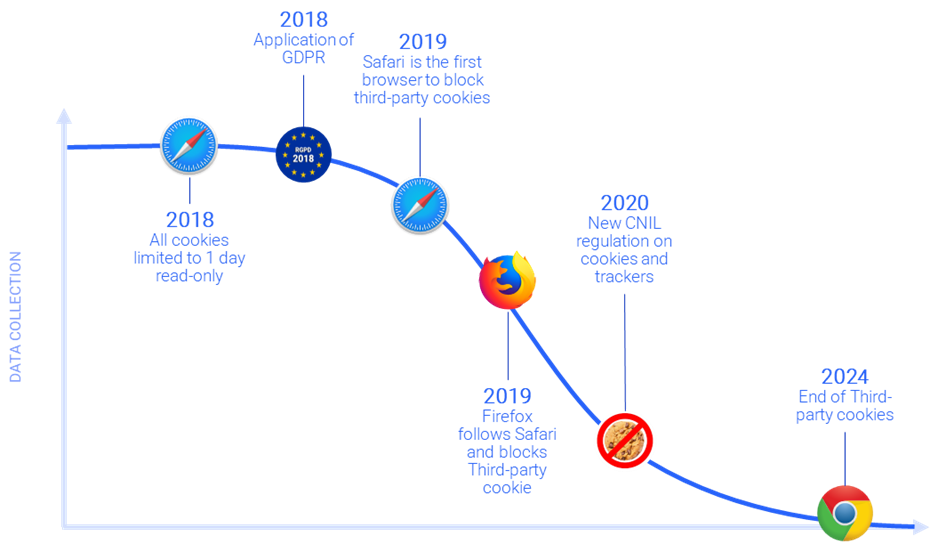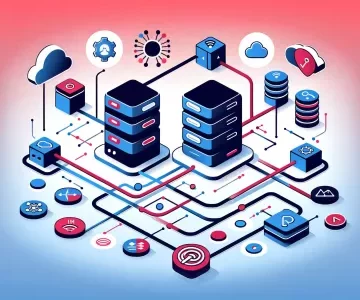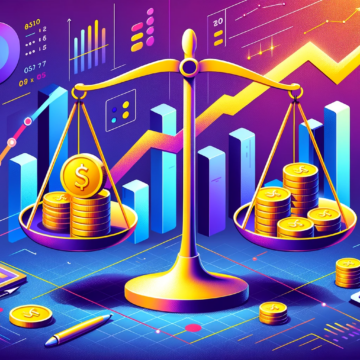The end of third-party cookies – What impact on your marketing campaigns?
06/12/2023 |


In the early days of digital marketing, everything was measurable. But over time, a number of factors have made access to data increasingly complex. Firstly, with the emergence of ad-blockers, and then with the birth of the GDPR, tracking users across different channels is becoming more difficult. With the announced end of third-party cookies, 34% of marketers believe that their main difficulty in 2024 will be continuing to track their users. So what impact will this have on the way marketing teams operate?
Third-party cookies: the end is in sight
While the first advertising banner, published online in 1994, marked the beginnings of digital marketing, it was only 4 years later that Google saw the light of day. A whole new world opened up for marketers, who took advantage of this craze to devise new acquisition strategies. For years, marketers had enjoyed total freedom in terms of measurement and user tracking, supported by the emergence of social networks (Facebook, Youtube, Twitter and Instagram), multiplying advertising signals sometimes to excess.

Then, in 2003, the first constraints appeared with the creation of Adblock, in particular, allowing users to free themselves from the quantity of advertising messages sent to them. In 2018, the first regulations saw the light of day with the creation of the GDPR. Internet users gradually became aware of the need to regulate and protect their privacy.

While today, the proportion of non-identifiable traffic via third-party cookies is 29% (on Safari and Firefox), after 2024, it is estimated that non-identifiable traffic will be 87%. As a result, 20% of professionals believe that they will have to review their entire digital strategies.

What are the consequences for the ecosystem?
Today, many questions are being asked about the ability of the ecosystem to respond to this challenge. The end of third-party cookies will affect the entire market, from advertisers and tech solutions to media partners.
Changes for advertisers
A less universal measure
For advertisers, the main challenge will be to measure user behaviour and ensure the effectiveness of campaigns in a world without cookies. Indeed, by 2024, advertisers will no longer be able to track a user’s buying journey and will be faced with the loss of information at all touch points – from the click on a banner through to conversion.
An increasingly compartmentalised digital world
In the absence of an identifier, and without the ability to trace user journeys across all contact points, marketers will be dependent on data supplied by the various partners (social platforms or publishers) and will have to rework this data a posteriori to obtain a unified, global view. A complex and time-consuming task.
Identify prospects on another site
Without the presence of their third-party cookie, advertisers will no longer be able to trace a visit and advertising exposure. They will find it more difficult to trace a prospect browsing a publisher’s site to an advertiser’s site (of the publisher type or on a social networking platform). Without the third-party cookie, there will be an impact on the ability of digital players to retarget these profiles correctly.
Changes for media platforms
In this context, advertisers will tend to turn to advertising platforms that guarantee the reliability and traceability of data from the major advertising platforms, to the benefit of Meta, Google and Tik Tok. The second impact is that marketers will prefer audiences that are logged in and therefore identifiable.
What’s new for Tech solutions
Platform publishers will have to educate themselves to identify and communicate these new standards to the market. The challenge is to propose alternatives and encourage their adoption and implementation.
What are the consequences for digital teams?
While this paradigm shift affects the entire ecosystem, it will also have consequences for the day-to-day work of digital teams at every stage of a marketing campaign.
- Identification: The first challenge is to recognise visitors who browse advertisers’ websites and to be able to identify prospects in order to better control advertising exposure.
- In terms of data collection: the end of third-party cookies will have an impact on the capture of signals and therefore on the ability of digital teams to build complete and reliable leads. Reporting will also be impacted by this reduction in the amount of data collected.
- Measurement: digital teams will not be able to measure the cycles and frequencies of visits, the number of new visitors, post-views, post-clicks, etc. as accurately. The loss of attribution of a campaign click to a visitor to the site is estimated at around 30%.
- Reporting: with the end of third-party cookies, creating reports on your website’s audience, campaign performance and the effectiveness of media investments is becoming increasingly complex.
- Finally, in terms of activation: it will be more difficult to target useful audiences, or to remarket to certain user profiles (shopping basket abandonment, engagement, etc.).
To sum up, the impact of the end of third-party cookies is not to be taken lightly, but practical solutions do exist to deal with this loss of data. The transition to data collection based on first-party or server-side data, combined with the use of an anonymous and persistent ID, is undoubtedly the turning point to be adopted in 2024.











